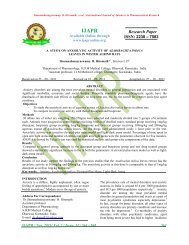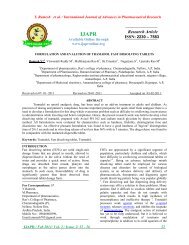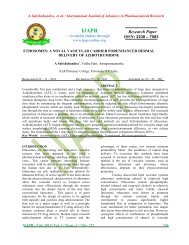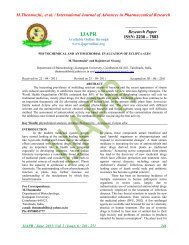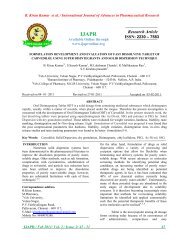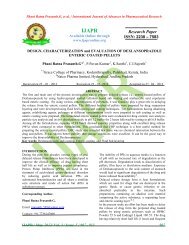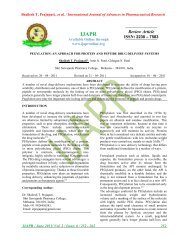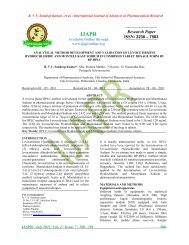20110918_Hitesh Jain et al, IJAPR.pdf - international journal of ...
20110918_Hitesh Jain et al, IJAPR.pdf - international journal of ...
20110918_Hitesh Jain et al, IJAPR.pdf - international journal of ...
You also want an ePaper? Increase the reach of your titles
YUMPU automatically turns print PDFs into web optimized ePapers that Google loves.
<strong>Hitesh</strong> <strong>Jain</strong>., <strong>et</strong> <strong>al</strong>. / Internation<strong>al</strong> Journ<strong>al</strong> <strong>of</strong> Advances in Pharmaceutic<strong>al</strong> Research<br />
<strong>IJAPR</strong><br />
Available Online through<br />
www.ijapronline.org<br />
Review Article<br />
ISSN: 2230 – 7583<br />
DENDRIMERS: A NOVEL DRUG DELIVERY SYSTEM<br />
<strong>Hitesh</strong> <strong>Jain</strong>*, Prasanna Pradhan , Parth Patel, Kruti Joshi, U.M. Upadhyay<br />
Sigma Institute <strong>of</strong> Pharmacy, Baroda, Gujarat, India. hitesh_hitachi@rediffmail.com, 09924469131<br />
Received on 08 – 05 - 2011 Revised on 14 – 06- 2011 Accepted on 21 – 06 – 2011<br />
ABSTRACT<br />
Dendrimers are hyperbranched macromolecules having tree like structure, consisting <strong>of</strong> a core molecule and<br />
<strong>al</strong>ternating layers <strong>of</strong> monomers. They can be synthesized by divergent and convergent growth m<strong>et</strong>hods. During<br />
synthesis, properties like dendrimer size, molecular mass, surface group can be controlled and configured to the<br />
desired need. The ability <strong>of</strong> dendrimers to encapsulate and bind the guest molecule can be used for solubility<br />
enhancement, sustained release and drug delivery applications. The reflections on biomedic<strong>al</strong> and industri<strong>al</strong><br />
applications <strong>of</strong> dendrimers given in this report clearly demonstrate the potenti<strong>al</strong> <strong>of</strong> this new fourth major class <strong>of</strong><br />
polymer architecture and indeed substantiate the high hopes for the future <strong>of</strong> dendrimers.<br />
Keywords: Dendrimer, Divergent growth, Solubility enhancement, Drug delivery<br />
INTRODUCTION<br />
A dendrimers are gener<strong>al</strong>ly described as a<br />
macromolecule, which is characterized by its<br />
highly branched 3D structure that provides a high<br />
degree <strong>of</strong> surface function<strong>al</strong>ity and versatility.<br />
Polymer chemistry and technology have<br />
tradition<strong>al</strong>ly focused on linear polymers, which<br />
are widely in use. Linear macromolecules only<br />
occasion<strong>al</strong>ly contain some sm<strong>al</strong>ler or longer<br />
branches. In the recent past it has been found that<br />
the properties <strong>of</strong> highly branched macromolecules<br />
can be very different from convention<strong>al</strong> polymers.<br />
The structure <strong>of</strong> these materi<strong>al</strong>s has <strong>al</strong>so a great<br />
impact on their applications. First discovered in<br />
the early 1980’s by Don<strong>al</strong>d Tom<strong>al</strong>ia and coworkers,<br />
these hyper branched molecules were<br />
c<strong>al</strong>led dendrimers. The term originates from<br />
‘dendron’ meaning a tree in Greek. At the same<br />
time, Newkome’s group independently reported<br />
synthesis <strong>of</strong> similar macromolecules. They c<strong>al</strong>led<br />
them arborols from the Latin word ‘arbor’ <strong>al</strong>so<br />
1, 2, 3<br />
meaning a tree.<br />
Structure <strong>of</strong> dendrimers<br />
Dendrimers are built from a starting atom, such as<br />
nitrogen, to which carbon and other elements are<br />
added by a repeating series <strong>of</strong> chemic<strong>al</strong> reactions<br />
that produce a spheric<strong>al</strong> branching structure. As<br />
the process repeats, successive layers are added,<br />
and the sphere can be expanded to the size<br />
required by the investigator. The result is a<br />
spheric<strong>al</strong> macromolecular structure whose size is<br />
similar to <strong>al</strong>bumin and hemoglobin, but sm<strong>al</strong>ler<br />
than such multimers as the gigantic IgM antibody<br />
complex.<br />
Dendrimers possess three distinguished<br />
4, 5, 6<br />
architectur<strong>al</strong> components<br />
(i) An initiator core.<br />
(ii) Interior layers (generations) composed <strong>of</strong><br />
repeating units, radic<strong>al</strong>ly attached to the interior<br />
core.<br />
(iii) Exterior (termin<strong>al</strong> function<strong>al</strong>ity) attached to<br />
the outermost interior generations, as shown in<br />
figure 1.<br />
Components <strong>of</strong> dendrimers<br />
1. Generation<br />
It is the hyper branching when going from the<br />
centre <strong>of</strong> the dendrimer towards the periphery,<br />
resulting in homo structur<strong>al</strong> layers b<strong>et</strong>ween the<br />
foc<strong>al</strong> points (branching points). The number <strong>of</strong><br />
foc<strong>al</strong> points when going from the core towards the<br />
dendrimer surface is the generation number. That<br />
is a dendrimer having five foc<strong>al</strong> points when<br />
going from the centre to the periphery is denoted<br />
as the 5th generation dendrimer. Here, we<br />
<strong>IJAPR</strong> / July 2011/ Vol. 2 / Issue. 7 / 340 - 347 340
<strong>Hitesh</strong> <strong>Jain</strong>., <strong>et</strong> <strong>al</strong>. / Internation<strong>al</strong> Journ<strong>al</strong> <strong>of</strong> Advances in Pharmaceutic<strong>al</strong> Research<br />
abbreviate this term to simply a G5-dendrimer,<br />
e.g. a 5th generation polypropylene imine is<br />
abbreviated to a “G5-PPI-” dendrimer, The core<br />
part <strong>of</strong> the dendrimer is som<strong>et</strong>imes denoted<br />
generation “zero”, or in the terminology presented<br />
here “G0”. The core structure thus presents no<br />
foc<strong>al</strong> points, as hydrogen substituents are not<br />
considered foc<strong>al</strong> points. Intermediates during the<br />
dendrimer synthesis are som<strong>et</strong>imes denoted h<strong>al</strong>fgenerations,<br />
a well-known example is the<br />
carboxylic acid-terminated PAMAM dendrimers.<br />
2. Shell<br />
The dendrimer shell is the homo-structur<strong>al</strong> spati<strong>al</strong><br />
segment b<strong>et</strong>ween the foc<strong>al</strong> points, the “generation<br />
space”. The “outer shell” is the space b<strong>et</strong>ween the<br />
last outer branching point and the surface. The<br />
“inner shells” are gener<strong>al</strong>ly referred to as the<br />
dendrimer interior.<br />
3. Pincer<br />
In dendrimers, the outer shell consists <strong>of</strong> a<br />
varying number <strong>of</strong> pincers created by the last<br />
foc<strong>al</strong> point before reaching the dendrimer surface.<br />
In PPI and PAMAM dendrimers the number <strong>of</strong><br />
pincers is h<strong>al</strong>f the number <strong>of</strong> surface groups<br />
(because in these dendrimers the chain divides<br />
into two chains in each foc<strong>al</strong> point).<br />
4. End-group<br />
It is <strong>al</strong>so gener<strong>al</strong>ly referred to as the “termin<strong>al</strong><br />
group” or the “surface group” <strong>of</strong> the dendrimer.<br />
Dendrimers having amine end-groups are termed<br />
“amino-terminated dendrimers”, as shown in<br />
figure 2.<br />
4, 7, 8, 9<br />
Types <strong>of</strong> dendrimers<br />
1. Pamam dendrimer<br />
Poly (amidoamine) dendrimers (PAMAM) are<br />
synthesized by the divergent m<strong>et</strong>hod starting from<br />
ammonia or <strong>et</strong>hylenediamine initiator core<br />
reagents. Products up to generation 10 (7) (a<br />
molecular weight <strong>of</strong> over 9, 30,000 g/mol) have<br />
been obtained (by comparison, the molecular<br />
weight <strong>of</strong> human hemoglobin is approximately<br />
65,000 g/mol). PAMAM dendrimers are<br />
commerci<strong>al</strong>ly available, usu<strong>al</strong>ly as m<strong>et</strong>hanol<br />
solutions. Starburst dendrimers is applied as a<br />
trademark name for a sub-class <strong>of</strong> PAMAM<br />
dendrimers based on a tris-amino<strong>et</strong>hylene-imine<br />
core. The name refers to the star like pattern<br />
observed when looking at the structure <strong>of</strong> the<br />
high-generation dendrimers <strong>of</strong> this type in twodimensions.<br />
2. Pamamos dendrimer<br />
Radi<strong>al</strong>ly layered poly(amidoamine-organosilicon)<br />
dendrimers (PAMAMOS) are inverted<br />
unimolecular micelles that consist <strong>of</strong> hydrophilic,<br />
nucleophilic polyamidoamine (PAMAM) interiors<br />
and hydrophobic organosilicon (OS) exteriors.<br />
These dendrimers are exception<strong>al</strong>ly useful<br />
precursors for the preparation <strong>of</strong> honeycomb-like<br />
n<strong>et</strong>works with nanoscopic PAMAM and OS<br />
domains.<br />
3. PPI dendrimer<br />
PPI-dendrimers stand for “Poly (Propylene<br />
Imine)” describing the propylamine spacer<br />
moi<strong>et</strong>ies in the oldest known dendrimer type<br />
developed initi<strong>al</strong>ly by Vögtle. (8) These dendrimers<br />
are gener<strong>al</strong>ly poly-<strong>al</strong>kyl amines having primary<br />
amines as end groups, the dendrimer interior<br />
consists <strong>of</strong> numerous <strong>of</strong> tertiary tris-propylene<br />
amines. PPI dendrimers are commerci<strong>al</strong>ly<br />
available up to G5, and has found widespread<br />
applications in materi<strong>al</strong> science as well as in<br />
biology. As an <strong>al</strong>ternative name to PPI, POPAM<br />
is som<strong>et</strong>imes used to describe this class <strong>of</strong><br />
dendrimers. POPAM stands for Poly (Propylene<br />
Amine), which closely resembles the PPI<br />
abbreviation. In addition, these dendrimers are<br />
<strong>al</strong>so som<strong>et</strong>imes denoted “DAB-dendrimers”<br />
where DAB refers to the core structure, which is<br />
usu<strong>al</strong>ly based on Diamino butane.<br />
4. Tecto dendrimer<br />
These are composed <strong>of</strong> a core dendrimer,<br />
surrounded by dendrimers <strong>of</strong> sever<strong>al</strong> steps (each<br />
type design) to perform a function necessary for a<br />
smart therapeutic nanodevice. Different<br />
compounds perform varied functions ranging<br />
from diseased cell recognition, diagnosis <strong>of</strong><br />
disease state drug delivery, reporting location to<br />
reporting outcomes <strong>of</strong> therapy.<br />
5. Multilingu<strong>al</strong> dendrimers<br />
In these dendrimers, the surface contains multiple<br />
copies <strong>of</strong> a particular function<strong>al</strong> group.<br />
6. Chir<strong>al</strong> dendrimers<br />
The chir<strong>al</strong>ity in these dendrimers are based upon<br />
the construction <strong>of</strong> a constitution<strong>al</strong>ly different but<br />
chemic<strong>al</strong>ly similar branches to chir<strong>al</strong> core.<br />
7. Hybrid dendrimers linear polymers<br />
These are hybrids (block or graft polymers) <strong>of</strong><br />
dendritic and linear polymers.<br />
8. Amphiphilic dendrimers<br />
They are built with two segregated sites <strong>of</strong> chain<br />
end, one h<strong>al</strong>f is electron donating and the other<br />
h<strong>al</strong>f is electron withdrawing.<br />
<strong>IJAPR</strong> / July 2011/ Vol. 2 / Issue. 7 / 340 - 347 341
<strong>Hitesh</strong> <strong>Jain</strong>., <strong>et</strong> <strong>al</strong>. / Internation<strong>al</strong> Journ<strong>al</strong> <strong>of</strong> Advances in Pharmaceutic<strong>al</strong> Research<br />
9. Micellar dendrimers<br />
These are unimolecular micelles <strong>of</strong> water soluble<br />
hyper branched polyphenylenes.<br />
10. Multiple antigen peptide dendrimers<br />
It is a dendron-like molecular construct based<br />
upon a polylysine skel<strong>et</strong>on. Lysine with its <strong>al</strong>kyl<br />
amino side-chain serves as a good monomer for<br />
the introduction <strong>of</strong> numerous <strong>of</strong> branching points.<br />
11. Fréch<strong>et</strong>-type dendrimers<br />
It is a more recent type <strong>of</strong> dendrimers developed<br />
by Hawker and Fréch<strong>et</strong> 6, 8 based on poly-benzyl<br />
<strong>et</strong>her hyper branched skel<strong>et</strong>on. These dendrimers<br />
usu<strong>al</strong>ly have carboxylic acid groups as surface<br />
groups, serving as a good anchoring point for<br />
further surface fiction<strong>al</strong>ization, and as polar<br />
surface groups to increase the solubility <strong>of</strong> this<br />
hydrophobic dendrimers type in polar solvents or<br />
aqueous media.<br />
Construction <strong>of</strong> dendrimers<br />
Most syntheses <strong>of</strong> dendrimers involve the<br />
rep<strong>et</strong>itious <strong>al</strong>ternation <strong>of</strong> a growth reaction and an<br />
activation reaction. Often, these reactions have to<br />
be performed at many sites on the same molecule<br />
simultaneously. Clearly, the reactions must be<br />
very 'clean' and high yielding for the construction<br />
<strong>of</strong> large targ<strong>et</strong>s to be feasible. Many dendrimer<br />
syntheses rely upon tradition<strong>al</strong> reactions, such as<br />
the Michael reaction, or the Williamson <strong>et</strong>her<br />
synthesis, whilst others involve the use <strong>of</strong> modern<br />
techniques and chemistry, such as solid-phase<br />
synthesis, organotransition-m<strong>et</strong><strong>al</strong> chemistry,<br />
organosilicon chemistry, organo-phosphorus<br />
chemistry, or other contemporary organic<br />
m<strong>et</strong>hodologies. The choice <strong>of</strong> the growth reaction<br />
dictates the way in which branching is introduced<br />
into the dendrimer. Branching may either be<br />
present in the building blocks as is more <strong>of</strong>ten the<br />
case or it can be created as a function <strong>of</strong> the<br />
growth reaction, as is the case with the PAMAMs<br />
and the poly (propylene imine)s. For d<strong>et</strong>ails <strong>of</strong> the<br />
chemistry employed in the production <strong>of</strong><br />
dendrimers, there are many comprehensive works<br />
which can be referred to by the reader 10-21<br />
1. 'Divergent' dendrimer growth<br />
The synth<strong>et</strong>ic m<strong>et</strong>hodology employed in the early<br />
dendrimer syntheses came to be known as the<br />
'divergent' approach. This name comes from the<br />
way in which the dendrimer grows outwards from<br />
the core, diverging into space. A schematic<br />
representation <strong>of</strong> divergent growth is shown in<br />
figure 3. Starting from a reactive core, a<br />
generation is grown, and then the new periphery<br />
<strong>of</strong> the molecule is activated for reaction with<br />
more monomers. The two steps can be repeated.<br />
The divergent approach is successful for the<br />
production <strong>of</strong> large quantities <strong>of</strong> dendrimers since,<br />
in each generation-adding step, the molar mass <strong>of</strong><br />
the dendrimer is doubled. Very large dendrimers<br />
have been prepared in this way, but incompl<strong>et</strong>e<br />
growth steps and side reactions lead to the<br />
isolation and characterisation <strong>of</strong> slightly imperfect<br />
samples 22 . Divergently grown dendrimers are<br />
virtu<strong>al</strong>ly impossible to isolate pure from their side<br />
products. The synth<strong>et</strong>ic chemist must rely on<br />
extremely efficient reactions in order to ensure<br />
low polydispersities.<br />
2. 'Convergent' dendrimer growth<br />
The 'convergent' approach was developed as a<br />
response to the weaknesses <strong>of</strong> divergent<br />
syntheses. A schematic representation <strong>of</strong><br />
divergent growth is shown in figure 4.Convergent<br />
growth begins at what will end up being the<br />
surface <strong>of</strong> the dendrimer, and works inwards by<br />
gradu<strong>al</strong>ly linking surface units tog<strong>et</strong>her with more<br />
monomers. When the growing wedges are large<br />
enough, sever<strong>al</strong> are attached to a suitable core to<br />
give a compl<strong>et</strong>e dendrimer. The advantages <strong>of</strong><br />
convergent growth over divergent growth stem<br />
from the fact that only two simultaneous reactions<br />
are required for any generation-adding step. Most<br />
importantly, this protocol makes the purification<br />
<strong>of</strong> perfect dendrimers simple.<br />
There are <strong>al</strong>so certain other advantages associated<br />
with convergent growth. The growth reactions do<br />
not have to be so stringently efficient, and it<br />
becomes possible to introduce subtle engineering<br />
into the dendritic structure. This principle will be<br />
examined in d<strong>et</strong>ail in the next section. Convergent<br />
syntheses are not without their own shortcomings,<br />
however. The number <strong>of</strong> steps required to build<br />
up a large structure is not reduced compared with<br />
the divergent approach, y<strong>et</strong> a great de<strong>al</strong> more<br />
starting materi<strong>al</strong> is required. The convergent<br />
m<strong>et</strong>hodology <strong>al</strong>so suffers from low yields in the<br />
synthesis <strong>of</strong> large structures. Dendritic wedges <strong>of</strong><br />
higher generations encounter serious steric<br />
problems in the reactions <strong>of</strong> their 'foc<strong>al</strong> points'.<br />
<strong>IJAPR</strong> / July 2011/ Vol. 2 / Issue. 7 / 340 - 347 342
<strong>Hitesh</strong> <strong>Jain</strong>., <strong>et</strong> <strong>al</strong>. / Internation<strong>al</strong> Journ<strong>al</strong> <strong>of</strong> Advances in Pharmaceutic<strong>al</strong> Research<br />
3. 'Hypercores' and 'Branched’ monomers 23<br />
Hypercores and branched monomers <strong>al</strong>low the<br />
chemist to devise synth<strong>et</strong>ic strategies that are<br />
more convergent in the classic<strong>al</strong> synth<strong>et</strong>ic sense<br />
<strong>of</strong> the word. An interesting comparison <strong>of</strong><br />
convergent, divergent, and hypercore synthesis in<br />
the preparation <strong>of</strong> phenylac<strong>et</strong>ylene dendrimers<br />
was attempted by Moore, but solubility problems<br />
in the divergent steps made the convergent<br />
approach favourable.<br />
4. 'Double exponenti<strong>al</strong>' and 'Mixed' growth 24<br />
The most recent fundament<strong>al</strong> breakthrough in the<br />
practice <strong>of</strong> dendrimer synthesis has come with the<br />
concept and implications <strong>of</strong> 'double exponenti<strong>al</strong>'<br />
growth. Double exponenti<strong>al</strong> growth, similar to a<br />
rapid growth technique for linear polymers,<br />
involves an AB2 monomer with orthogon<strong>al</strong><br />
protecting groups for the A and B function<strong>al</strong>ities.<br />
This approach <strong>al</strong>lows the preparation <strong>of</strong><br />
monomers for both convergent and divergent<br />
growth from a single starting materi<strong>al</strong>. These two<br />
products are reacted tog<strong>et</strong>her to give an<br />
orthogon<strong>al</strong>ly protected trimer, which may be used<br />
to repeat the growth process again as shown in<br />
figure 5.<br />
M<strong>et</strong>hods for characterization <strong>of</strong> dendritic<br />
polymer 25<br />
The development <strong>of</strong> mass spectroscopic<br />
techniques such as MALDI and electrospray mass<br />
spectrom<strong>et</strong>ry has <strong>al</strong>lowed the absolute<br />
d<strong>et</strong>ermination <strong>of</strong> dendrimer perfection. Mass<br />
spectrom<strong>et</strong>ric results on dendrimers demonstrate<br />
the extreme sensitivity <strong>of</strong> the technique and the<br />
uniformity <strong>of</strong> the molecular mass. Scattering<br />
techniques measure the radius <strong>of</strong> gyration (Rg) <strong>of</strong><br />
dendrimers, which is an average <strong>of</strong> the spati<strong>al</strong><br />
distribution <strong>of</strong> <strong>al</strong>l <strong>of</strong> the units. Transmission<br />
electron microscopy (TEM) has been used to<br />
image individu<strong>al</strong> dendritic molecules, usu<strong>al</strong>ly the<br />
larger generations. Recently atomic force<br />
microscopy (AFM) has <strong>al</strong>so been used to image<br />
dendritic molecules.<br />
Following m<strong>et</strong>hods can be used for<br />
characterization <strong>of</strong> dendritic polymers.<br />
1. Spectroscopy and spectrom<strong>et</strong>ry m<strong>et</strong>hods like<br />
Nuclear Magn<strong>et</strong>ic Resonance (NMR), Infra-red<br />
(IR) and Raman, Ultra-viol<strong>et</strong>-visible (UV-VIS),<br />
Fluorescence, Chir<strong>al</strong>ity, Optic<strong>al</strong> rotation, Circular<br />
dichroism (CD), X-ray diffraction, and Mass<br />
spectrom<strong>et</strong>ry<br />
2. Scattering techniques like Sm<strong>al</strong>l angle X-ray<br />
scattering (SAXS), Sm<strong>al</strong>l angle neutron scattering<br />
(SANS), and Laser light scattering (LLS)<br />
3. Electric<strong>al</strong> techniques like Electron<br />
paramagn<strong>et</strong>ic resonance (EPR), Electrochemistry,<br />
and Electrophoresis<br />
4. Size exclusion chromatography (SEC)<br />
5. Microscopy like Transmission electron<br />
microscopy, Scanning electron microscopy and<br />
atomic force microscopy<br />
6. Rheology, physic<strong>al</strong> properties like intrinsic<br />
viscosity, Differenti<strong>al</strong> Scanning C<strong>al</strong>orim<strong>et</strong>ry<br />
(DSC), and Dielectric spectroscopy (DS)<br />
7. Miscellaneous like X-ray Photoelectron<br />
Spectroscopy (XPS), measurements <strong>of</strong> dipole<br />
moments, titrim<strong>et</strong>ry, <strong>et</strong>c.<br />
Comparison <strong>of</strong> characterization <strong>of</strong><br />
dendritic<strong>al</strong>ly branched polymers by SANS,<br />
SAXS, and TEM<br />
Sm<strong>al</strong>l angle neutron scattering (SANS), sm<strong>al</strong>l<br />
angle x-ray scattering (SAXS), and transmission<br />
electron microscopy (TEM) have been used to<br />
characterize the size, shape and interactions <strong>of</strong><br />
dendrimers, hyper branched, and dendrigraft<br />
polymers. Size in terms <strong>of</strong> radius <strong>of</strong> gyration (Rg)<br />
from scattering and diam<strong>et</strong>er from microscopy<br />
can be routinely measured. Five technologic<strong>al</strong>ly<br />
important factors <strong>of</strong> dendritic<strong>al</strong>ly branched<br />
polymers have been identified and measured.<br />
Applications <strong>of</strong> dendrimers<br />
Delivery <strong>of</strong> anticancer drugs by<br />
dendrimers and dendritic polymers.<br />
<br />
<br />
<br />
<br />
<br />
Dendrimers in gene transfection.<br />
Dendrimer in drug delivery.<br />
Use <strong>of</strong> dendrimers to cross cellular<br />
barriers.<br />
Dendritic medic<strong>al</strong> imaging systems.<br />
Dendrimers in photodynamic therapy.<br />
<strong>IJAPR</strong> / July 2011/ Vol. 2 / Issue. 7 / 340 - 347 343
<strong>Hitesh</strong> <strong>Jain</strong>., <strong>et</strong> <strong>al</strong>. / Internation<strong>al</strong> Journ<strong>al</strong> <strong>of</strong> Advances in Pharmaceutic<strong>al</strong> Research<br />
<br />
<br />
<br />
CONCLUSION<br />
Dendrimers as solubility enhancer.<br />
New Dendritic Adhesives for Sutureless<br />
Ophth<strong>al</strong>mic Surgic<strong>al</strong> Procedures.<br />
Dendrimers as Nano-Drugs<br />
The dendrimers holds a promising future in various<br />
pharmaceutic<strong>al</strong> applications and diagnostic field in<br />
the coming years as they possess unique properties,<br />
such as high degree <strong>of</strong> branching, multiv<strong>al</strong>ency,<br />
globular architecture and well-defined molecular<br />
weight, thereby <strong>of</strong>fering new scaffolds for drug<br />
delivery. An increasingly large number <strong>of</strong> drugs<br />
being developed today facing problems <strong>of</strong> poor<br />
solubility, bioavailability and permeability.<br />
Dendrimers can work as a useful tool for optimizing<br />
drug delivery <strong>of</strong> such problematic drugs. Also the<br />
problem <strong>of</strong> biocompatibility and toxicity can be<br />
overcome by careful surface engineering. Recent<br />
successes in simplifying and optimizing the synthesis<br />
<strong>of</strong> dendrimers provide a large vari<strong>et</strong>y <strong>of</strong> structures<br />
with reduced cost <strong>of</strong> their production. Also as<br />
research progresses, newer applications <strong>of</strong><br />
dendrimers will emerge and the future should witness<br />
an increasing numbers <strong>of</strong> commerci<strong>al</strong>ized dendrimer<br />
based drug delivery systems. The high level <strong>of</strong><br />
control over the architecture <strong>of</strong> dendrimers, their size,<br />
shape, branching length and density, and their surface<br />
function<strong>al</strong>ity, makes these compounds ide<strong>al</strong> carriers<br />
in biomedic<strong>al</strong> applications such as drug delivery,<br />
gene transfection and imaging.<br />
Figure 1: The Dendritic Structure<br />
<strong>IJAPR</strong> / July 2011/ Vol. 2 / Issue. 7 / 340 - 347 344
<strong>Hitesh</strong> <strong>Jain</strong>., <strong>et</strong> <strong>al</strong>. / Internation<strong>al</strong> Journ<strong>al</strong> <strong>of</strong> Advances in Pharmaceutic<strong>al</strong> Research<br />
Figure 2: Three dimension<strong>al</strong> projection <strong>of</strong> dendrimer core-shell architecture for G=4.5 PAMAM<br />
dendrimer with princip<strong>al</strong> architectur<strong>al</strong> components (I) core, (II) interior & (III) surface<br />
Figure 3: Divergent dendrimers growth<br />
<strong>IJAPR</strong> / July 2011/ Vol. 2 / Issue. 7 / 340 - 347 345
<strong>Hitesh</strong> <strong>Jain</strong>., <strong>et</strong> <strong>al</strong>. / Internation<strong>al</strong> Journ<strong>al</strong> <strong>of</strong> Advances in Pharmaceutic<strong>al</strong> Research<br />
Figure 4: Convergent dendrimer growth<br />
Figure 5: Double exponenti<strong>al</strong> and mixed growth<br />
REFERENCES<br />
1. Tom<strong>al</strong>ia DA, Baker H, Dew<strong>al</strong>d JR.,<br />
K<strong>al</strong>los G, Martin S, Roeck J, Ryder J,<br />
Smith P. A new class <strong>of</strong> polymers:<br />
Starburst- dendritic macromolecules.<br />
Polym. J. 1985, 17, 117–132.<br />
2. Newkome GR, Yao ZQ, Baker GR,<br />
Gupta VK. Cascade molecules: A new<br />
approach to micelles. J. Org. Chem.<br />
1985, 50.<br />
3. F. Vögtle E, Weber A. Chem. Int. Ed.<br />
Engl., 1974, 13, 814-815.<br />
4. Pushkar S, Philip A, Pathak K and<br />
Pathak D, “Dendrimers: Nanotechnology<br />
Derived Novel Polymers in Drug<br />
Delivery”, Indian J. Pharm. Educ. Res.<br />
2006, 40 (3), 153-158.<br />
5. Sakthivel T, Florence AT, “Adsorption<br />
<strong>of</strong> Amphipathic Dendrons on<br />
Polystyrene Nanoparticles”, Int. J.<br />
Pharm. 2003, 254, 23-26.<br />
6. Yiyun C, Zhenhua X, Minglu M,<br />
Tonguen X, “Dendrimers as Drug<br />
<strong>IJAPR</strong> / July 2011/ Vol. 2 / Issue. 7 / 340 - 347 346
<strong>Hitesh</strong> <strong>Jain</strong>., <strong>et</strong> <strong>al</strong>. / Internation<strong>al</strong> Journ<strong>al</strong> <strong>of</strong> Advances in Pharmaceutic<strong>al</strong> Research<br />
Carriers: Applications in Different<br />
Routes <strong>of</strong> Drug”, J.Pharma.Sci. 2008,<br />
97(1), 123-143.<br />
7. Hawker C, Fréch<strong>et</strong> JMJ. A new<br />
convergent approach to monodisperse<br />
dendritic molecule. J. Chem. Soc.<br />
Chem. Commun. 1990, 15, 1010-1012.<br />
8. Hawker C, Wooley KL, Fréch<strong>et</strong> JMJ.<br />
J.Chem. Soc. Perkin. Trans. 1993, 1,<br />
1287-1289.<br />
9. Frech<strong>et</strong> JMJ, Tom<strong>al</strong>ia DA. “Introduction<br />
to the Dendritic state”, Dendrimers and<br />
other Dendritic Polymers, John Wiley &<br />
Sons Ltd, 2001, 24-23.<br />
10. Cram DJ, Cram JM. Science, 1974, 183,<br />
803-809.<br />
11. Cram DJ. Chem. Int. Ed. Engl., 1988,<br />
27, 1009-1020.<br />
12. Lehn JM. Acc. Chem. Res., 1978, 11,<br />
49-57.<br />
13. Suckling CJ. J. Chem. Soc., Chem.<br />
Commun., 1982, 661-662.<br />
14. Hyatt JA. J. Org. Chem., 1978, 43,<br />
1808-1811; Y. Murakami, A. Nakano,<br />
K..<br />
15. E. Buhleier, W. Wehner, F. Vögtle,<br />
Synthesis, 1978, 155-158.<br />
16. R. Moors F. Vögtle, Chem. Ber., 1993,<br />
126, 2133-2135.<br />
17. Wörner C, Mülhaupt R. Chem. Int. Ed.<br />
Engl., 1993, 32, 1306-1308.<br />
18. O'Sullivan DA. C & EN, 1993, 16, 20-<br />
23.<br />
19. FloryPJ. J. Am. Chem. Soc., 1952, 74,<br />
2718-2723.<br />
20. Maciejewski M. J. Macromol. Sci.<br />
Chem., 1982, A17(4), 689-703.<br />
21. Tom<strong>al</strong>ia DA, Baker H, Dew<strong>al</strong>d J, H<strong>al</strong>l<br />
M, K<strong>al</strong>los G, Martin S, Roeck, J, Ryder<br />
P. Polym. J. 1985, 17, 117-132.<br />
22. Newkome GR, Yao Z, Baker GR, Gupta<br />
VK. J. Org. Chem., 1985, 50, 2004-<br />
2006.<br />
23. Naylor M, Goddard WA, Kiefer GE,<br />
Tom<strong>al</strong>ia DA. J. Am. Chem. Soc., 1989,<br />
111, 2339-2341.<br />
24. Patel R <strong>et</strong> <strong>al</strong>. “Dendrimers: A new<br />
innovation in drug delivery”, Pharma Bio<br />
World, 2007, 42-52.<br />
25. Caminade AM, Laurent R, Major<strong>al</strong> JP,<br />
Characterization <strong>of</strong> dendrimers.<br />
Advanced Drug Delivery Reviews, 2005,<br />
57, 2130-2146.<br />
<strong>IJAPR</strong> / July 2011/ Vol. 2 / Issue. 7 / 340 - 347 347



